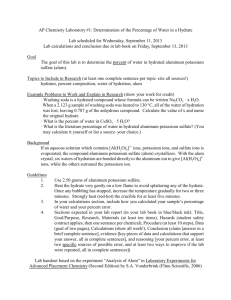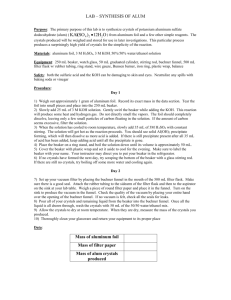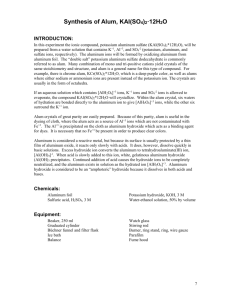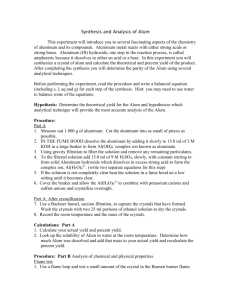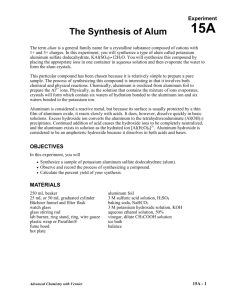Synthesis of Alum: KAl(SO4)2
advertisement
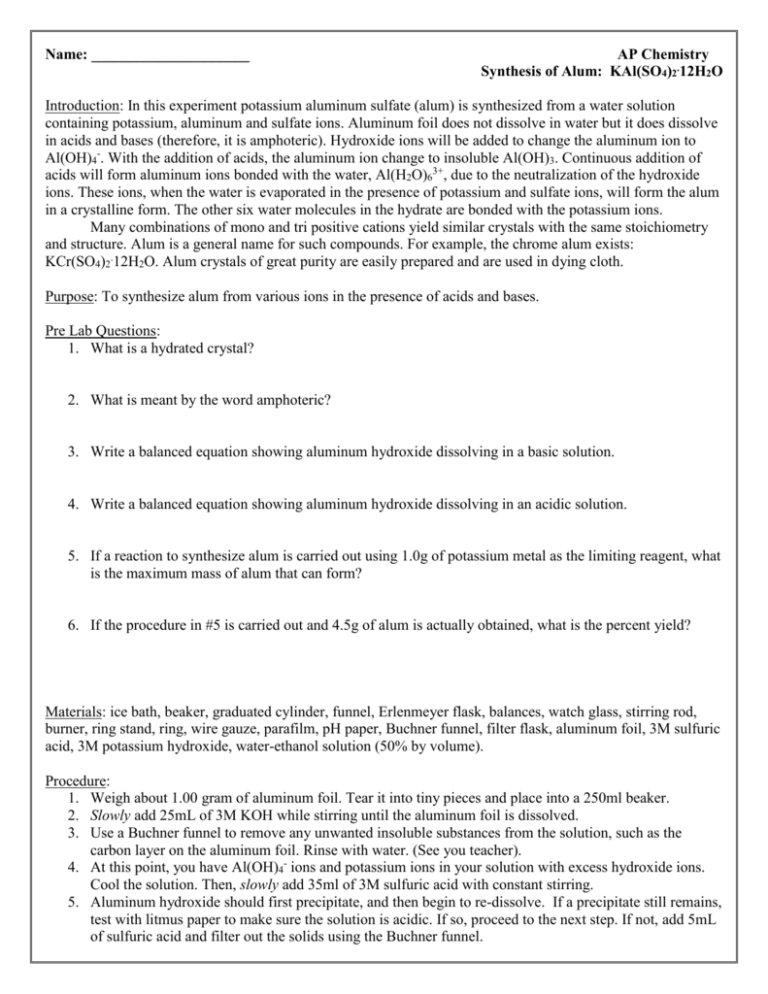
Name: _____________________ AP Chemistry Synthesis of Alum: KAl(SO4)2.12H2O Introduction: In this experiment potassium aluminum sulfate (alum) is synthesized from a water solution containing potassium, aluminum and sulfate ions. Aluminum foil does not dissolve in water but it does dissolve in acids and bases (therefore, it is amphoteric). Hydroxide ions will be added to change the aluminum ion to Al(OH)4-. With the addition of acids, the aluminum ion change to insoluble Al(OH)3. Continuous addition of acids will form aluminum ions bonded with the water, Al(H2O)63+, due to the neutralization of the hydroxide ions. These ions, when the water is evaporated in the presence of potassium and sulfate ions, will form the alum in a crystalline form. The other six water molecules in the hydrate are bonded with the potassium ions. Many combinations of mono and tri positive cations yield similar crystals with the same stoichiometry and structure. Alum is a general name for such compounds. For example, the chrome alum exists: KCr(SO4)2.12H2O. Alum crystals of great purity are easily prepared and are used in dying cloth. Purpose: To synthesize alum from various ions in the presence of acids and bases. Pre Lab Questions: 1. What is a hydrated crystal? 2. What is meant by the word amphoteric? 3. Write a balanced equation showing aluminum hydroxide dissolving in a basic solution. 4. Write a balanced equation showing aluminum hydroxide dissolving in an acidic solution. 5. If a reaction to synthesize alum is carried out using 1.0g of potassium metal as the limiting reagent, what is the maximum mass of alum that can form? 6. If the procedure in #5 is carried out and 4.5g of alum is actually obtained, what is the percent yield? Materials: ice bath, beaker, graduated cylinder, funnel, Erlenmeyer flask, balances, watch glass, stirring rod, burner, ring stand, ring, wire gauze, parafilm, pH paper, Buchner funnel, filter flask, aluminum foil, 3M sulfuric acid, 3M potassium hydroxide, water-ethanol solution (50% by volume). Procedure: 1. Weigh about 1.00 gram of aluminum foil. Tear it into tiny pieces and place into a 250ml beaker. 2. Slowly add 25mL of 3M KOH while stirring until the aluminum foil is dissolved. 3. Use a Buchner funnel to remove any unwanted insoluble substances from the solution, such as the carbon layer on the aluminum foil. Rinse with water. (See you teacher). 4. At this point, you have Al(OH)4- ions and potassium ions in your solution with excess hydroxide ions. Cool the solution. Then, slowly add 35ml of 3M sulfuric acid with constant stirring. 5. Aluminum hydroxide should first precipitate, and then begin to re-dissolve. If a precipitate still remains, test with litmus paper to make sure the solution is acidic. If so, proceed to the next step. If not, add 5mL of sulfuric acid and filter out the solids using the Buchner funnel. 6. Boil the solution until the water has evaporated to give a total volume of 50mL. Cool the solution at room temperature. 7. Cool the solution in an ice bath for 15 minutes keeping it motionless (located on the teacher’s desk). Crystals should form. If not, reheat the solution to drive off more water and then scratch the bottom of the inside of the beaker and re-cool. 8. Collect the crystals using vacuum filtration (Buchner funnel). Wash with water-ethanol solution. 9. Allow the crystals to dry overnight. 10. Mass the alum and record. Questions/Calculations: 1. Record observations of your alum. 2. Why should you not expect 100% yield? 3. How does solubility of alum in water change with temperature? 4. Write balanced net ionic equations for these reactions that occurred during the synthesis of alum. a. Aluminum reacts with KOH and water forming potassium ions, tetrahydroxylaluminate (III) ions and hydrogen gas. b. Hydrogen ions from the acid react with tetrahydroxylaluminate (III) ions to precipitate aluminum hydroxide. c. Aluminum hydroxide reacts with additional hydrogen ions and water to form Al(H2O)63+. d. Alum forms from potassium ions, hydrated aluminum ions and sulfate ions in water. 5. Calculate the theoretical mass of alum using masses of potassium ions from KOH, aluminum from the foil and sulfate from the sulfuric acid. 6. Calculate your percent yield.
